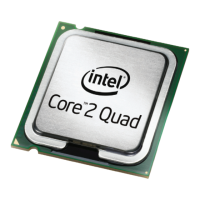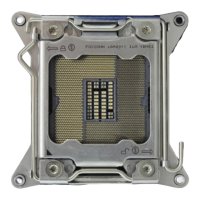Quad-Core Intel® Xeon® Processor 5300 Series Datasheet 89
Thermal Specifications
To provide greater flexibility in environmental conditions and thermal solution design,
the Nominal Thermal Profile and the Short-Term Thermal Profile are each specified 5°C
above the NEBS Level 3 ambient operating temperature requirements of 40°C nominal
and 55°C short-term. The Nominal Thermal Profile is defined at an ambient operating
temperature of 45°C, and the Short-Term Thermal Profile is defined at an ambient
operating temperature of 60°C.
Both of these thermal profiles ensure adherence to Intel reliability requirements. It is
expected that the Thermal Control Circuit (TCC) would only be activated for very brief
periods of time when running the most power intensive applications. Utilization of a
thermal solution that exceeds the Short-Term Thermal Profile, or which operates at the
Short-Term Thermal Profile for a duration longer than the specified limits will violate the
thermal specifications and may result in permanent damage to the processor. Refer to
the Quad-Core Intel® Xeon® Processor LV 5318 in Embedded Applications Thermal/
Mechanical Design Guidelines for details on system thermal solution design, thermal
profiles and environmental considerations.
Notes:
1. These values are specified at V
CC_MAX
for all processor frequencies. Systems must be designed to ensure
the processor is not to be subjected to any static V
CC
and I
CC
combination wherein V
CC
exceeds V
CC_MAX
at
specified I
CC
. Please refer to the loadline specifications in Section 2.
2. Maximum Power is the highest power the processor will dissipate, regardless of its VID. Maximum Power is
measured at maximum T
CASE
.
3. Thermal Design Power (TDP) should be used for processor thermal solution design targets. TDP is not the
maximum power that the processor can dissipate. TDP is measured at maximum T
CASE
.
4. These specifications are based on silicon characterization.
5. Power specifications are defined at all VIDs found in Table 2-3. The Quad-Core Intel® Xeon® Processor
E5300 may be shipped under multiple VIDs for each frequency.
6. FMB, or Flexible Motherboard, guidelines provide a design target for meeting all planned processor
frequency requirements.
Table 6-1. Quad-Core Intel® Xeon® Processor E5300 Series Thermal Specifications
Core
Frequency
Maximum
Power
(W)
Thermal
Design Power
(W)
Minimum
T
CASE
(°C)
Maximum
T
CASE
(°C)
Notes
Launch to FMB 100 80 5 See Figure 6-1;
Table 6-2
1, 2, 3, 4, 5, 6

